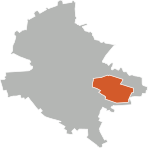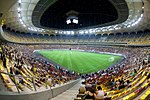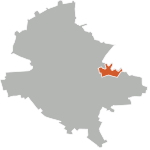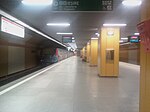Titan metro station
1981 establishments in RomaniaBucharest Metro stationsEuropean rapid transit stubsRailway stations opened in 1981Romania transport stubs ... and 1 more
Romanian railway station stubs

Titan is a metro station in Bucharest located in the Titan district. The station services the now rather obsolete shopping center, the large Titan Park and the district's dense population. The station was opened on 28 December 1981 as part of the second phase of Line 1 between Timpuri Noi and Republica.The station is an open-vault metro station, the largest without any support pillars on the network. To facilitate construction, impressive efforts had to be done: the soil was frozen for 90 days, and the technology used to make it was also one of the few technologies imported from other countries to construct the metro.
Excerpt from the Wikipedia article Titan metro station (License: CC BY-SA 3.0, Authors, Images).Titan metro station
Strada Liviu Rebreanu, Bucharest Titan - Balta Albă (Sector 3)
Geographical coordinates (GPS) Address Nearby Places Show on map
Geographical coordinates (GPS)
| Latitude | Longitude |
|---|---|
| N 44.42501 ° | E 26.16269 ° |
Address
Bd. Nicolae Grigorescu
Strada Liviu Rebreanu
031784 Bucharest, Titan - Balta Albă (Sector 3)
Romania
Open on Google Maps










